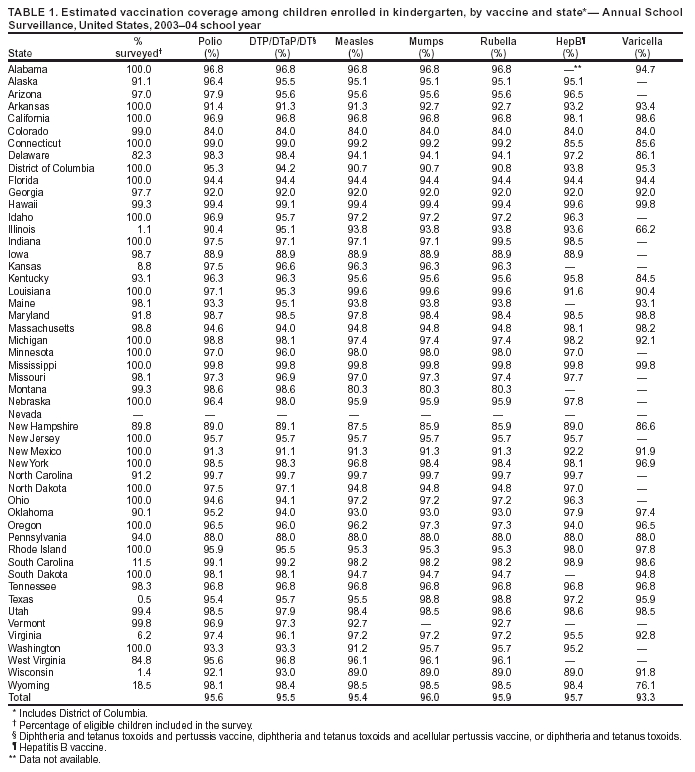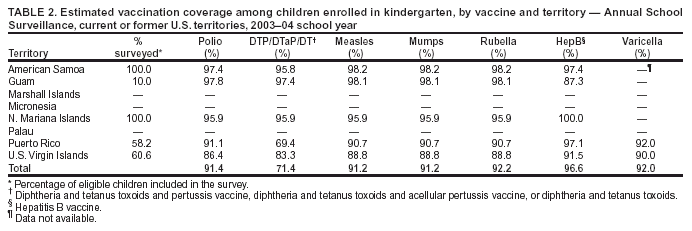 |
|
|
|
|
|
|
| ||||||||||
|
|
|
|
|
|
|
||||
| ||||||||||
|
|
|
|
|
Persons using assistive technology might not be able to fully access information in this file. For assistance, please send e-mail to: mmwrq@cdc.gov. Type 508 Accommodation and the title of the report in the subject line of e-mail. Vaccination Coverage Among Children Entering School --- United States, 2003--04 School YearOne of the national health objectives for 2010 is to sustain >95% vaccination coverage among children in kindergarten through first grade (objective 14-23) (1). To determine the percentage of vaccination coverage among children entering kindergarten, data on vaccination coverage were analyzed from reports submitted to the National Immunization Program by states, the District of Columbia (DC)*, and eight current or former U.S. territories for the 2003--04 school year. This report summarizes the results of that analysis, which determined that coverage for all vaccines except hepatitis B (HepB) and varicella was reported at >90% in 45 areas. However, the vaccines required in each reporting area and the methods for surveying kindergarten-aged children vary substantially; in seven states, <20% of eligible children were surveyed. The wide variations in survey populations underscore the need for CDC to continue working with immunization programs in states, DC, and current or former territories to improve survey methods and automate reporting of data. For the 2003--04 school year, all states except one submitted reports of vaccination coverage levels for children entering kindergarten. Fifty reports included coverage for poliovirus vaccine, diphtheria and tetanus toxoids and pertussis vaccine, diphtheria and tetanus toxoids and acellular pertussis vaccine, or diphtheria and tetanus toxoids (DTP/DTaP/DT), measles vaccine, and rubella vaccines; 49 reports included coverage for mumps vaccine (Table 1). Coverage for HepB vaccine was included in 43 reports, and coverage for varicella vaccine was included in 33 state reports. DC reported on all of the vaccination coverages. When determining coverage, up-to-date (UTD) status was used rather than number of doses because the doses required to be UTD vary depending on timing of vaccinations, area requirements regarding number of doses, and brand of vaccines. The number of state reports based on 100% of children entering kindergarten increased from 18 in the 2002--03 school year to 22 in 2003--04 (2). In an additional 21 states, coverage was assessed in surveys of >80% of eligible children. In the remaining seven states, coverage was assessed in surveys of <20% of eligible children (range: 0.5%--18.5%). National estimates of coverage were calculated by weighting each state's coverage estimate by the size of the state's kindergarten enrollment. Coverage for all vaccines except HepB and varicella was reported at 90%--95% in 16 (31.3%) states and at >95% in 29 (56.9%) states (Table 1). Nationally, coverage was reported at >95% for all vaccines except varicella, for which coverage was 93.3%. Five (63%) of the eight current or former U.S. territories reported data for the 2003--04 school year. All five reports included coverage for poliovirus vaccine, DTP/DTaP/DT vaccine, and vaccines for measles, mumps, rubella, and HepB (Table 2). Two territories reported coverage for 1 dose of varicella vaccine. The percentage of children surveyed by the current or former U.S. territories ranged from 10.0% to 100.0%. Coverage for all vaccines except DTP/DTaP/DT vaccine was reported to be >86%. Reported by: B Lyons, MPH, C Stanwyck, PhD, Immunization Svcs Div; M McCauley, MTSC, National Immunization Program, CDC. Editorial Note:CDC has increased efforts to help states and current or former U.S. territories collect and report data on vaccination coverage among children entering school by providing a new online reporting system, available since the 2002--03 school year. Anecdotal reports from states indicate that the online reporting system, which automates data management and calculation tasks, has made it easier for states to report their coverage. CDC also has encouraged greater standardization of reporting; unlike previous reports, this report is based only on coverage among children entering kindergarten, rather than on a mix of those children and first graders. State laws requiring proof of vaccination before entering school have been referred to as a "safety net" for the U.S. vaccination program because they ensure that no child is missed (3). This safety net relies on the efforts of school nurses, teachers, and others to identify children who are not UTD. Findings of uniformly high nationwide coverage during the 2002--03 and 2003--04 school years underscore the success of school entry requirements in boosting vaccine coverage. Childhood vaccination coverage is also measured nationally among children aged 19--35 months (4). Higher percentages of children are UTD at kindergarten entry than at younger ages, suggesting that school entry laws are a key to ensuring high coverage. The findings in this report are subject to at least two limitations. First, methods for assessing vaccination coverage among children entering school vary because state and local laws determine which vaccines and doses are required, and sampling methods differ. The substantial variation in sampling methods among states limits the comparability of these data. Second, children attending private schools and those who are home-schooled were not surveyed by all states. The difference in vaccination rates between children schooled at home and children in traditional school environments is unknown. Additional information about assessing and reporting vaccination coverage among children entering school is available from the National Immunization Program Immunization Information Hotline, telephone 800-232-2522 (English) or 800-232-0233 (Spanish), or by e-mail at nipinfo@cdc.gov. References
* For this report, DC is included in state totals.
Table 1  Return to top. Table 2  Return to top.
Disclaimer All MMWR HTML versions of articles are electronic conversions from ASCII text into HTML. This conversion may have resulted in character translation or format errors in the HTML version. Users should not rely on this HTML document, but are referred to the electronic PDF version and/or the original MMWR paper copy for the official text, figures, and tables. An original paper copy of this issue can be obtained from the Superintendent of Documents, U.S. Government Printing Office (GPO), Washington, DC 20402-9371; telephone: (202) 512-1800. Contact GPO for current prices. **Questions or messages regarding errors in formatting should be addressed to mmwrq@cdc.gov.Page converted: 11/10/2004 |
|||||||||
This page last reviewed 11/10/2004
|